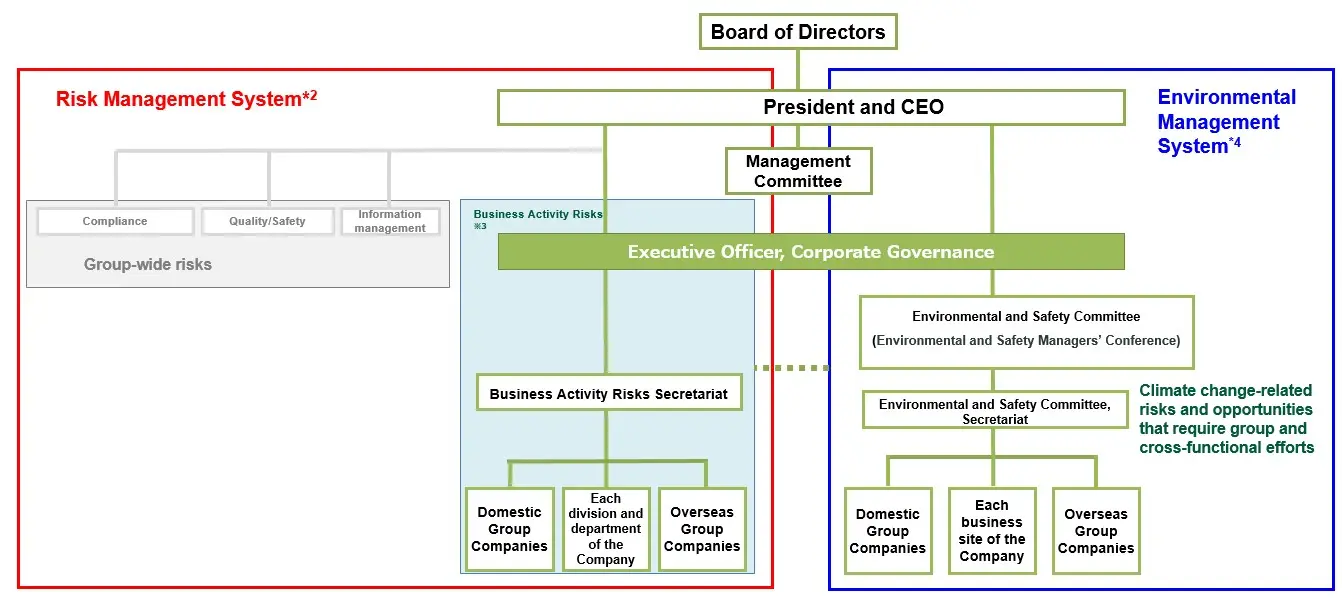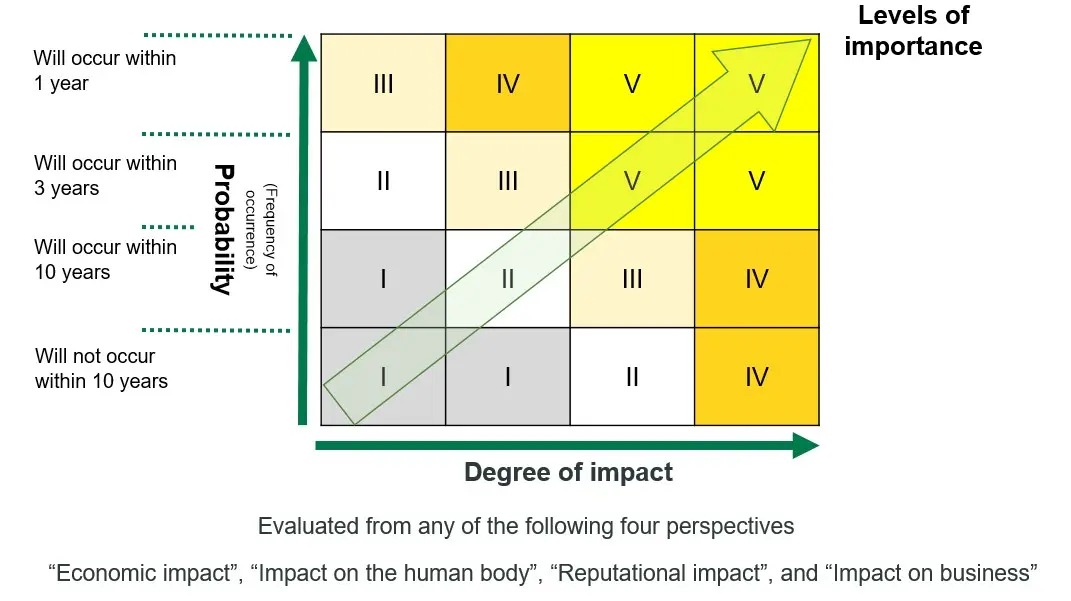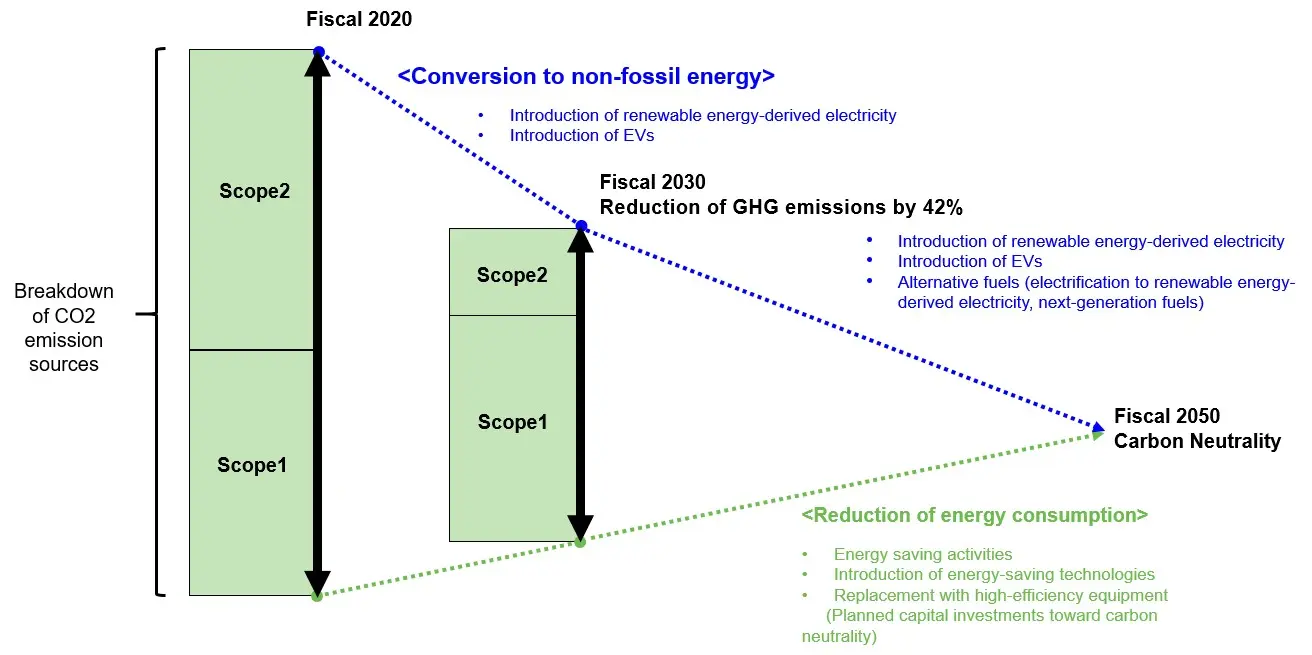Information Disclosure Based on TCFD Recommendations (Response to Climate Change)
In November 2021, Sumitomo Pharma announced its support for the TCFD recommendations*1and, concerning climate change-related risks and opportunities, we proceeded with initiatives in line with the TCFD recommendations and disclosed the information for the first time in April 2022. Since the disclosure, in order to fully prepare ourselves for climate change by facilitating the initiatives continuously, we have been promoting dialog with stakeholders based on the disclosed information. We will further reduce the risks of climate change and precisely seize its opportunities, by continuing to value dialog with our stakeholders, reexamining the risks and opportunities due to climate change from various perspectives, and thinking about them from the aspects of both climate change -related "mitigation" and "adaptation." Sumitomo Pharma will include the promotion of its response to climate change in "environmental initiatives", one of the Material Issues forming the foundation for business continuity. With an awareness of the financial impacts of environmental changes on our business, we will incorporate responses to risks and opportunities in our management strategies.
Governance
We have developed a risk management system*2 overseen by the President under the supervision of the Board of Directors and carry out comprehensive risk management. With regard to "business activity risks,"*3 including climate change-related risks and opportunities, we have established a Business Activity Risks Secretariat under the supervision of the executive officer in charge of corporate governance, and carry out annual company-wide risk assessments through the presidents of domestic and overseas Group companies and heads of all business units, and formulate necessary countermeasures based on the results followed by implementation and evaluation. These details are reported regularly, at least once a year, to the Board of Directors by the executive officer in charge, where discussions are held on important matters such as key action plans and risk management policies, and countermeasures are directed where necessary. With regard to issues related to climate change, such as the reduction of GHG(Greenhouse Gas)emissions, that require group or cross-divisional initiatives, we hold discussions at the Environmental and Safety Committee, under the environmental management system*4 and incorporate them into our medium- to long-term environmental goals*5. In addition, we make planned capital investments (investment toward carbon neutrality) and other investments that contribute to the reduction of GHG emissions based on our Mid-term Business Plan. Our initiatives to tackle climate change under the environmental management system will be reported to the Board of Directors at least once a year as part of our sustainability initiatives, and opportunities for briefings by experts will be considered when necessary.
- *2For more information on Risk Management Promotional Framework, please see "Risk Management."
- *3Disasters such as earthquakes, typhoons, heavy rains, epidemics, and infectious diseases, as well as risks associated with business activities, such as procurement, production, inventory management, and human resource management, that each company undertakes on its own responsibility
- *4For more information on Environmental Management Structure, please see "Environmental Management."
- *5For more information on medium- to long-term environmental goals, please see "Environmental Goals and Performance."

Figure1 "Governance" System Chart for Climate Change-Related Risks/Opportunities
Strategy
We evaluate risks and opportunities due to climate change according to the two aspects of "degree of impact*6" and "probability*7" as a primary evaluation, and classify them into five "levels of importance" from "I" to "V", according to the combination of these two aspects (Figure 2). In doing so, "degree of impact" is evaluated in consideration of the degree of progress on measures taken. For risks and opportunities that are ranked "III" or higher by the primary evaluation, we conduct a more detailed secondary evaluation using our scenarios for evaluation (1.5℃ and 4℃)*9, which are created with reference to 1.5℃ scenarios*8 and 4℃ scenarios*8, and for significant risks and opportunities identified by the secondary evaluation, we estimate the potential financial impact by making as many detailed assumptions as possible and promote countermeasures.
- *6"Degree of impact" will be evaluated on any of "economic impact", "impact on the human body", "reputational impact" and "impact on business."
- *7 "Probability" will be evaluated by frequency of occurrence on a time scale of 1 year (short term), 3 years (medium term) and 10 years (long term).
- *8AR6 (RCP1.9 and RCP8.5) issued by IPCC (Intergovernmental Panel on Climate Change), NZE and STEPS issued by the IEA (International Energy Agency) World Energy Outlook 2024, and various predicted values and peripheral information from the Ministry of the Environment
- *9"A world where sustainability is emphasized and progress is made in laws and regulations and technological development toward fossil fuel substitution," is assumed in the 1.5℃ scenario, while "a world where convenience and efficiency are emphasized and climate-related risks such as flooding have increased" is assumed in the 4℃ scenario.

Figure2 Risk map
Table <Risks and Opportunities due to Climate Change>
| Scenario | Risk classification |
Risk details | Financial impact |
Countermeasures | ||
|---|---|---|---|---|---|---|
| 1.5℃ and 4℃ |
Physical risks |
Acute risks |
Flooding, inundation and landslides caused by typhoons and heavy rain disrupt supplies of raw materials and purchased products as well as the sales and supply of the Company's products. | ー*10 | Adaptation | • Formulate BCP to reinforce stable supply structure • Avoid supply disruptions by optimizing inventories • Enhance stability of procurement by diversifying suppliers |
| 1.5℃ | Transition risks |
Policy and legal risks | Introduction of carbon tax results in tax burden depending of CO2 emissions. | Approx. ¥1.1 billion /year*11 |
Mitigation | Implement various measures toward achieving fiscal 2050 goals*5 • Achieve reinforced fiscal 2030 goals*5 with a view to achieving long-term goals. • Continue the planned transition to non-fossil energy. • Continue planned investment in carbon neutral equipment. • Continue energy saving measures . |
| Market risks |
Introduction of carbon tax results in increasing costs of supplies, deliveries, and related energies. | Approx. ¥6.4 billion /year*11 |
Mitigation | • Encourage business partners including suppliers to reduce greenhouse gas (GHG) emissions.
• Make constant efforts toward resource and energy savings through technology development and improved operational efficiency. |
||
| Scenario | Opportunity classification |
Opportunity details | Financial impact |
Countermeasures | ||
|---|---|---|---|---|---|---|
| 1.5℃ and 4℃ |
Opportunities | Resource efficiency |
Reducing water withdrawal helps to reduce costs. It also indirectly contributes to the reduction of GHG emissions generated in the process of supplying tap water and treating wastewater, and to the maintenance of ecosystems by protecting water intake sources. | Minor*13 | Mitigation | Implement various measures toward achieving fiscal 2030 goals*4 • We have installed water-saving nozzles on the faucets at some facilities. We will continue to proactively promote initiatives in this area. |
- *10Varies depending on the scale of the disaster and items to be affected.
- *11Calculated by multiplying CO2 emissions in fiscal 2023 of
approximately 54,000 t (Scope 1 and 2 emissions on a consolidated basis)†1 by IEA’s assumed carbon price for developed countries in 2030 of 140
USD/t-CO2 (hereafter, "assumed carbon price"). Assuming an exchange rate of 150
yen/USD.
†1 For more information on boundary of calculation, please see "Carbon Neutrality." - *12Calculated by multiplying fiscal 2023 CO2 emissions for Scope 3
Category 1
"Purchased goods and services" and Category 4 "Transportation and distribution (upstream)" of approximately
306,000 t†2 by assumed carbon price.
†2 For more information on boundary of calculation, please see "Carbon Neutrality." - *13Stated qualitatively as it is difficult to estimate the indirect contribution.
Management of risks and opportunities
Integration of the process for identifying and evaluating risks and opportunities due to climate change into comprehensive risk management
We have integrated the process for identifying and evaluating risks and opportunities due to climate change into the risk management system. Under the risk management system, we carry out annual risk assessments for all business units, including Group companies in Japan and overseas, and the results are aggregated to identify significant risks. With regard to climate change, we also use this assessment to extract and evaluate risks and opportunities, and view it as one of the risks that could affect our company in the medium to long term.
Process for managing climate change-related risks and opportunities
For climate change-related risks and opportunities, we devise measures, formulate annual plans to implement them, and evaluate progress annually, under the coordination of the risk management system and environmental management system. For example, for natural disasters (typhoons, heavy rains, flooding), which fall under the category of "acute risk" as physical risks, we promote the formulation of business continuity plans (BCP) etc. mainly under the risk management system. With regard to the reduction of GHG emissions in preparation for the introduction of carbon taxes, which fall under the category of "Policy and Legal Risks" as "transition risks", we formulate and manage medium- to long-term environmental goals mainly under the environmental management system.
Metrics and Targets
We take appropriate measures to respond to individual risks and opportunities due to climate change by thinking about them from the aspects of both climate change-related "mitigation" and "adaptation", as shown in the above table - Risks and Opportunities due to Climate Change. For carbon tax risks that fall under "Policy and Legal Risks" as transition risks, we are working to reduce GHG emissions by setting quantitative targets from the aspect of "mitigation." For Scope 1 and 2 emissions, we raised our target in fiscal 2022 to "reduce GHG emissions (Scope 1+2) by 42% from fiscal 2020 level by fiscal 2030."*14 In addition, for Scope 3 emissions, which account for approximately 85% of our GHG emissions, we have set a target to "reduce GHG emissions (Scope 3 Category 1 (purchased goods and services)) by 25% from fiscal 2020 level by fiscal 2030."*14 These GHG emission reduction targets have been approved by the Science Based Targets initiative (SBTi), and are scientifically valid and consistent with the levels required by the Paris Agreement. Meanwhile, for natural disasters (typhoons, heavy rains, flooding), which fall under the category of "acute" physical risks, we are promoting the formulation of BCP*15, optimization of product inventories, and diversifying suppliers, from the aspect of "adaptation", some of which have been completed. In addition, we are implementing initiatives to enhance the effectiveness of our BCP by identifying and improving issues through annual training. As for opportunities, we will continue to work on reducing water withdrawal*16 in line with our medium- to long-term goals, and will continue to closely monitor the impact of climate change on the area of infectious diseases, where we are conducting research and development.
- *14For more information on the progress toward our target to reduce GHG emissions and our Scope 3 emissions, please see "Carbon Neutrality."
- *15For more information on formulation of BCP and related matters, please see "Risk Management."
- *16For more information on the progress on our target to reduce water withdrawal, please see "Water・Resource Circulation."

Figure3 Roadmap for reducing GHG emissions